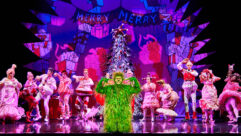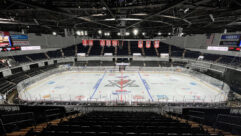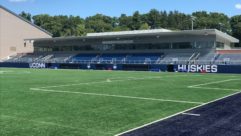
Venue Adds Expansive Sound System
A Las Vegas entertainment center sets out to install professional loudspeakers in multiple audio zones with the ability to route an audio source to or from any place in the building.
Four EAW MK 2396 loudspeakers provide sound reinforcement to TAO’s VIP Monk Room, aptly named for the hand-carved statues gracing its walls.
CHALLENGE: Provide complete sound coverage for a 42,000- square-foot entertainment complex with the ability to follow the party anywhere it happens.
SOLUTION: Install professional loudspeakers in multiple audio zones with the ability to route an audio source to or from any place in the building.
Bigger is better, at least when it comes to Las Vegas entertainment these days. Continuing the trend of adding entertainment venues to the mix, Las Vegas hotels have steadily transformed from casino stops to full-scale dining and entertainment complexes. The $20 million TAO at the Venetian is no exception, billing itself as an “Asian city” contained in a 42,000-square-foot complex.
The 400-seat restaurant, banquet facilities, ultra-lounge, and 10,000-square-foot nightclub designed by Studio Gaia and Thomas Schoos Design opened in September 2005. Klai-Juba Architects of Las Vegas served as architects of record. Inside, a hand-carved 20-foot-tall Buddha greets visitors as it floats atop a reflecting pool filled with koi fish. A moat area nearby contains floating tables for VIPs, while a catwalk to the women’s bathroom serves as a pseudo-runway for the fashionable set. Above, eight private skyboxes are outfitted with mini-bars and espresso machines. Each day, 160 staff members keep TAO running.
What sets TAO apart from its equally large and flashy brethren is the investment in AV, most notably the sound system, which covers every square inch of the complex, including hallways and bathrooms. “In Vegas, there are maybe 50 to 100 good restaurants,” says Rich Wolf, who co-owns TAO Las Vegas and sister restaurant TAO New York with his business partner Mark Packer. “If you dropped a glass in any of them, you’d be able to hear each shard hit the ground because it’s so quiet. We specialize in ‘vibe dining’ where it’s okay to bop in your seat or dance your way to the bathroom. You never know where the party will be, so the sound system has to follow.”
The nightclub at TAO may be a designated area, but not to Wolf, who describes TAO restaurant “as much like a nightclub as you can get, but still be a restaurant.” The party starts when the restaurant opens daily at 5 p.m., and doesn’t stop until the nightclub closes at 5 a.m. Unlike other venues that rely on canned sound effects or piped music to enhance the ambiance, TAO uses music from CDs to match the ambiance or DJ-driven music in the evenings to fill the complex with club energy. Like most major nightclubs, TAO pays licensing fees for the use of CDs to ASCAP and BMI based on capacity.
One-stop shopping
As a multi-use facility, TAO needed the support of a major hotel like the Venetian with the appropriate infrastructure. To take advantage of the location and proximity to convention traffic, the multipurpose venue caters to corporate parties during the week as well as to locals and tourists looking for entertainment on the weekends. “Drawing on the one-stop shopping mentality, you can have drinks, dinner, dancing, and a nightcap in one building at TAO,” Wolf says. “You don’t have to waste an hour trying to get to your next destination across town.”
For More Information
- Color Kineticswww.colorkinetics.com
- Crownwww.crownaudio.com
- dbxwww.dbxpro.com
- EAWwww.eaw.com
- ETA Systemswww.etasys.com
- Lutronwww.lutron.com
- MA Lightingwww.malighting.de
- Robewww.robe.cz
To design and install the vital sound system for TAO, Wolf brought in veteran designer and fellow club owner John Lyons, president of design-build company John Lyons Systems and owner of the Avalon clubs in Boston and New York as well as the Avalon and Spider Club in Los Angeles. At the time, Lyons was also designing and installing the sound system at another Vegas super club, Body English at the Hard Rock Hotel. “In a space like TAO, the coverage of the sound system is important, but so is the quality,” Lyons says. “Wolf wanted to be able to clear out all the tables in the restaurant and have a big party if the mood struck. To do so, all installed loudspeakers needed to keep up with the nightclub dance music.”
Lyons chose more than 20 different models of EAW loudspeakers for the install, which wasn’t that unusual considering the diverse areas needing sound coverage. For example, the multi-level dining area features 40-foot ceilings. The upper level is used for dining, but can also be used as a dance club space. They needed loudspeakers capable of producing high SPLs, but that wouldn’t mar the aesthetics. Lyons used eight EAW UB82 compact loudspeakers and EAW SB150r subwoofers to complement the flush-mounted EAW L8CX2XO ceiling speakers used on the lower level.
Because Las Vegas building code requires even low-voltage wires to be in conduit, Lyons worked with TAO’s electrical contractor to encase all 25,000 feet of the wiring in a flexible metal jacket. This helped to reduce costs, meet code, and also kept the wiring flexible enough to do long runs.
Multiple zones
TAO’s five distinct spaces — with a total of 154 installed loudspeakers — are independently zoned using dbx Zone Pro 641 and ZonePro 1260 processors. The nightclub is divided into the main dance floor and VIP area, mezzanine, and sky boxes. TAO’s ballroom is zoned as two rooms, but can be combined into one large room for corporate functions. The restaurant’s three zones include the main dining area, the upper level, and loft. Sound coverage in hallways and bathrooms are also zoned separately.
Two EAW DC2 subwoofers and a flying EAW DCS2 are just a small part of the nightclub sound system installed at TAO.
Using the ZonePros, sourced music is routed from CD or the DJ to anywhere in the complex. The install features a total of 32 wall-mounted remote controls, with capabilities ranging from simple volume control to more complex, programmable source selection and timed system changes throughout the day or week. Ten dbx ZC-1 remote volume controls are installed in the dining room, ballroom, and nightclub. Nine dbx ZC-3 remote source selectors featuring programmable rotary switch source selection, page assignment, or scene selection are installed in those rooms as well as in the terrace, VIP area, and sky boxes. Four dbx ZC-8 remote source selectors with programmable push-button volume control and programmable rotary switch source selection are installed in the dining room, loft, and nightclub. And for fire safety purposes, five dbx ZC-FIRE fire mute interface devices provide output muting.
Using the building’s local area network (LAN), the AV staff can view and manage the ZonePros as well as the multiple Crown I-Tech 4000 and 6000 amplifiers from any port in the LAN. “Because TAO is so big, it wasn’t designed with a central control room,” Lyons says. “There are multiple amp rooms spaced throughout the complex. A tech can troubleshoot the system from any network-connected IP, thanks to Crown’s IQWic software and the IQ network.”
Crown’s IQ Network is a computerized audio system that uses the company’s proprietary IQ protocol to enable remote control and monitoring of its amplifiers from a central or remote location. IQWic, Crown’s control and monitoring software, enables the control and monitoring of components via network connection.
Consistent Voicing
Selecting loudspeakers for a massive project like TAO is a difficult challenge for the system designer. With so many overlapping areas, it’s important to keep consistent sound quality and voicing from spilling from one area to another. The basis of any design looks at the application, but also takes into account performance characteristics, size of the cabinets, available coverage patterns, and the designer’s familiarity with the manufacturer’s products. John Lyons, president of design-build company John Lyons Systems and long-time development partner with EAW, found what he needed for TAO’s restaurant, bar, lounge and nightclub in EAW’s vast product line. According to Rich Frembes, product requirements manager at EAW, the company achieves consistent voicing in several ways:
- Working closely with transducer vendors to ensure that successive generations of drivers either meet past specifications or, in the case of clean sheet designs, incorporate long-standing EAW design philosophies into the new transducers. “Our ability to pick and choose from the best drivers on the market ensures consistently excellent performance from all our loudspeaker designs,” he adds.
- The use of proprietary software called FChart, authored by EAW’s research and development guru David Gunness, is used throughout EAW’s design and manufacturing process. FChart models all elements of a loudspeaker, including MF/HF horns, passive/active crossovers, and 3D polars. FChart is also used for data acquisition of completed designs, in the QC process during manufacturing, and is used along with SIA Smaart to verify designs in the field.
- Finally, EAW uses extensive peer reviews throughout the development process. “In addition to EAW engineering staff, many members of our Application Support Group and Sales organization also listen to products extensively during voicing exercises,” Frembes says. “This ensures that a broad spectrum of professional backgrounds and ‘ear memories’ are incorporated in each product.”
A dedicated power supply is used for the entire AV system, along with an independent ISO transformer. The power feed is completely separate from the hotel to minimize interference.
Additionally, two ETA Systems PD66 high-amperage power distribution systems are installed in the nightclub. “This allowed the racks to be pre-wired in the shop,” Lyons says. “All of the high-voltage power wiring can typically get bulky. By pre-installing a rack-mounted sub panel, the wire management could be done more thoughtfully, allowing for proper isolation that often gets overlooked.”
Corporate market
To better serve its corporate clients, TAO required that all video and lighting systems must be multi-use, i.e. for nightclub use in the evening and for presentations requiring use of the Internet or PowerPoint during the day. The original lighting design was completed by Steve Lieberman of SJ Lighting. Andrew Gumper, owner and president of AG Light & Sound in New York, was called in to further augment the video and lighting systems. “I augmented the design by adding color washes and moving some lighting fixtures to create a more intimate ambiance,” he says. “TAO’s strength is that it can offer a different feel than a hotel ballroom.”
The unique feel in TAO’s ballroom is much like an ancient temple. The lighting was tweaked to handle any requests from corporate clients, such as lighting a certain area of the room for dramatic effect, photography, or television, while leaving the rest untouched. As such, the lighting tech can control each individual fixture using DMX control and a Lutron dimming system control. Additional lighting elements at TAO include Color Kinetics LEDs on circle truss and Robe moving lights — all controlled using a MA Lighting grandMA console. Video elements were also added in the lounge and upper level dining areas using two built-in projection screens and projectors.
Given the overwhelming success of TAO, there’s no doubt that demand will continue to outstrip the supply of entertainment venues in Las Vegas. For the Venetian, the addition of TAO has brought added benefits. “TAO has brought a considerable increase in traffic of the 21- to 40-year-old market segment to the Venetian,” says Noah Tepperberg, who, along with business partner Jason Strauss, oversees marketing and operations for the complex.
Linda Seid Frembes is a freelance writer and PR specialist for the professional AV industry. She can be reached at [email protected].










